- Home
- Susan Wittig Albert
China Bayles' Book of Days
China Bayles' Book of Days Read online
Table of Contents
Title Page
Copyright Page
Acknowledgements
January February March
April May June
July August September
October November December
INDEX OF RECIPES
INDEX OF COSMETICS, CRAFTS, AND MEDICINES
SPECIAL FEATURES
PRAISE FOR THE CHINA BAYLES MYSTERIES . . .
“Mystery lovers who also garden will be captivated by this unique series.” —Seattle Post-Intelligencer
“One of the best-written and well-plotted mysteries I’ve read in a long time.” —Los Angeles Times
“An entertaining detective writer.” —The Dallas Morning News
“A nice book to curl up with on a blustery day.” —Chicago Tribune
“Albert has created captivating new characters and a setting dripping with atmosphere.” —Publishers Weekly
“[China Bayles is] such a joy . . . an instant friend.” —Carolyn G. Hart
“A treat for gardeners who like to relax with an absorbing mystery.”
—North American Gardener
“An appealing series.” —Booklist
“A wonderful reading experience.” —Midwest Book Review
“Gripping.” —Library Journal
“Cause for celebration.” —Rocky Mount (NC) Telegram
China Bayles Mysteries by Susan Wittig Albert
THYME OF DEATH
WITCHES’ BANE
HANGMAN’S ROOT
ROSEMARY REMEMBERED
RUEFUL DEATH
LOVE LIES BLEEDING
CHILE DEATH
LAVENDER LIES
MISTLETOE MAN
BLOODROOT
INDIGO DYING
AN UNTHYMELY DEATH
A DILLY OF A DEATH
DEAD MAN’S BONES
BLEEDING HEARTS
CHINA BAYLES’ BOOK OF DAYS
With her husband, Bill Albert, writing as Robin Paige
DEATH AT BISHOP’S KEEP
DEATH AT GALLOWS GREEN
DEATH AT DAISY’S FOLLY
DEATH AT DEVIL’S BRIDGE
DEATH AT ROTTINGDEAN
DEATH AT WHITECHAPEL
DEATH AT EPSOM DOWNS
DEATH AT DARTMOOR
DEATH AT GLAMIS CASTLE
DEATH IN HYDE PARK
DEATH AT BLENHEIM PALACE
DEATH ON THE LIZARD
Beatrix Potter Mysteries by Susan Wittig Albert
THE TALE OF HILL TOP FARM
THE TALE OF HOLLY HOW
THE TALE OF CUCKOO BROW WOOD
Nonfiction books by Susan Wittig Albert
WRITING FROM LIFE
WORK OF HER OWN
Most Berkley Prime Crime Books are available at special quantity discounts for bulk purchases for sales promotions, premiums, fund-raising, or educational use. Special books, or book excerpts, can also be created to fit specific needs.
For details, write: Special Markets, The Berkley Publishing Group, 375 Hudson Street, New York, New York 10014.
THE BERKLEY PUBLISHING GROUP
Published by the Penguin Group
Penguin Group (USA) Inc.
375 Hudson Street, New York, New York 10014, USA
Penguin Group (Canada), 90 Eglinton Avenue East, Suite 700, Toronto, Ontario M4P 2Y3, Canada
(a division of Pearson Penguin Canada Inc.)
Penguin Books Ltd., 80 Strand, London WC2R 0RL, England
Penguin Group Ireland, 25 St. Stephen’s Green, Dublin 2, Ireland (a division of Penguin Books Ltd.)
Penguin Group (Australia), 250 Camberwell Road, Camberwell, Victoria 3124, Australia
(a division of Pearson Australia Group Pty. Ltd.)
Penguin Books India Pvt. Ltd., 11 Community Centre, Panchsheel Park, New Delhi—110 017, India
Penguin Group (NZ), Cnr. Airborne and Rosedale Roads, Albany, Auckland 1310, New Zealand
(a division of Pearson New Zealand Ltd.)
Penguin Books (South Africa) (Pty.) Ltd., 24 Sturdee Avenue, Rosebank, Johannesburg 2196,
South Africa
Penguin Books Ltd., Registered Offices: 80 Strand, London WC2R 0RL, England
This is an original publication of The Berkley Publishing Group.
A nonfiction work inspired by the author’s favorite fictional characters.
Every effort has been made to ensure that the information contained in this book is complete and accurate. However, neither the publisher nor the author is engaged in rendering professional advice or services to the individual reader, and therefore neither is responsible for your specific health or allergy needs that may require medical supervision. The ideas, procedures, and suggestions contained in this book are not intended as a substitute for consulting with your physician. All matters regarding your health or dietary needs require medical supervision. Neither the author nor the publisher shall be liable or responsible for any loss or damage allegedly arising from any information or suggestion in this book.
PUBLISHER’S NOTE: While the author has made every effort to provide accurate Internet addresses at the time of publication, neither the
publisher nor the author assumes any responsibility for errors, or for changes that occur after publication. Further, publisher does not have any control over and does not assume any responsibility for the web site or its content.
All rights reserved.
No part of this book may be reproduced, scanned, or distributed in any printed or electronic form without permission. Please do not participate in or encourage piracy of copyrighted materials in violation of the author’s rights. Purchase only authorized editions.
The name BERKLEY PRIME CRIME and the BERKLEY PRIME CRIME design are trademarks belonging to Penguin Group (USA) Inc.
PRINTING HISTORY
Berkley Prime Crime trade paperback edition / October 2006
Library of Congress Cataloging-in-Publication Data
Albert, Susan Wittig.
China Bayles’ book of days : celebrating the mystery, myth, and magic of herbs : a treasury of
herbal lore, recipes, and crafts from the world of pecan springs / by Susan Wittig Albert.
p. cm.
Includes bibliographical references and index.
eISBN : 978-0-425-20653-9
1. Cookery (Herbs) 2. Herbs. I. Title.
TX819.H4A43 2006
641.6’57—dc22 2006008501
http://us.penguingroup.com
A NOTE TO READERS
I have herein communicated such Notions as I have gathered either from reading of several Authors, or by conferring sometimes with Scholars, and sometimes with Country people; To which I have added some Observations of mine own, never before published: Most of which I am confident are true, and if there be any that are not so, yet they are pleasant.
—WILLIAM COLE, THE ART OF SIMPLING, 1656
For years now, China Bayles has been nagging me about writing a book primarily about herbs—no murder, mayhem, or other unsavory doings, just herbs and the ways they are used in people’s lives. China isn’t the only one, either. I regularly receive letters that ask for information about growing and using herbs and close with the plaintive question: “When are you and China going to write a book about herbs?”
This book is our answer. In it, China and I have adopted the traditional format of the book of days, or daybook: the personal calendar in which people over the centuries have recorded meaningful events, ideas, things to do and to celebrate, and odds and ends of interest. A person’s daybook might record religious and national holidays, saints’ feast days, the sun’s passage through the zodiac and the phases of the moon, and info
rmation about planting and harvesting. For centuries, people have found such personal calendars indispensable, as a kind of collective memory of what was important in the past and what might be of importance in each day of the present year.
Because herbs play such an important part in China’s life, and in mine (and we hope in yours, too) our Book of Days is all about herbs. What is an herb? For me, the best and most inclusive definition is the one adopted by the Herb Society of America: Herbs are plants that are grown or gathered “for use and delight.” Herbs may grow tiny or tall, in the tropics or the deserts, in a wild meadow or in our gardens or on our windowsills. We may grow or gather these ourselves, or purchase the dried or processed plant material. Indeed, herbs are plants for use and delight.
In this book, China and I have gathered together tidbits and treasures about the plants we love to live with, as well as their many mysteries and myths and magical uses. There are quite a few practical items, too—recipes, crafts, gardening tips, and ideas for ways you can put more green into your daily life. The recipes are uncomplicated and designed for average cooks, but all feature the flavors of our favorite herbs. We’ve also featured a few people who know and grow herbs, and a few gardens and herb farms you might like to visit. And because China’s mysteries are all about herbs, we’ve included tidbits from her books, as well as brief essays about the mysteries and some special contributions by the irrepressible members of the Myra Merryweather Herb Guild, Pecan Springs’ oldest civic organization.
I became interested in herbs many years ago, as a doctoral candidate working with medieval English texts in which both medicinal and culinary herbs figured prominently. Among my efforts: the translation of the earliest English cookery text, A Forme of Cury, compiled in 1381 by Richard II’s cook for the Royal kitchen. For the past twenty years, growing and using and learning and writing about herbs has been a way of finding my place in life, on this green earth, and in this amazing universe, so full of mystery and magic. I have learned that when I live in harmony with the plants around me, with the circling seasons, and with the earth itself, I live in greater contentment and peace. And when China Bayles brought her herb shop into my life in the early 1990s, my sense of possibilities for living a green life grew even stronger. Perhaps this book will help you see how this can be true for you, too.
Some of this material has appeared in other forms: in the China Bayles Mysteries (I’ve noted the titles where appropriate); in the Book of Days pieces written for the Herb Companion from 1998-2002; in China’s Garden (the herbal newsletter that China and I published from 1994-1999); and in China’s pages on my web site (www.mysterypartners.com) and in “Lifescapes,” my Internet journal (www.susanalbert. blogspot.com). It has been revised and rewritten and assembled here in a format that China and I hope will please you. You will find reading suggestions throughout the book, a glossary, and an index of recipes, crafts, and medicinal preparations. (One word of caution: Herbs contain plant chemicals that can affect you in a variety of ways. Never take a therapeutic preparation of a plant until you have done your homework!)
China and I hope that you will keep this book where you can dip into it daily. We will be delighted if it sparks your own creative imagination and encourages you to create your own personal place in the green, growing world.
Susan Wittig Albert
Meadow Knoll, near Bertram, Texas
ACKNOWLEDGMENTS
I have plenty of people to thank for the material in this compilation of herbal history, lore, recipes, craft ideas, gardening tips, and factual information. I did not invent this stuff, folks; I collected it from here, there, and yonder, as herbalists have done from the beginning. My sources are acknowledged throughout the book, and I am grateful to each one. Special thanks goes to the staff of the Herb Society of America for help in researching dates; to Carolee Schneider, Jim Long, Theresa Loe, and Kathleen Halloran for their special contributions; and to the many herb-lovers across the country who badgered me into sitting down to write. Peggy Turchette’s artwork enlivens the book with humor and charm. Thank you, Peggy!
As someone else has famously remarked, it takes a village. I have been writing for the same publishing house, Berkley Books, for nearly fifteen years, and continue to be both enormously cheered and humbled by the constant support I have received there. I am especially grateful to Natalee Rosenstein, who recognized the merit in my first “garden cozy” and has encouraged my work ever since. And to copy editor Pamela Barricklow, my deepest thanks. This was not an easy manuscript, and I appreciate her careful attention.
And of course to Bill, ever and always, thanks and love.
January February March
JANUARY 1
Love and joy come to you
And to our wassail too
And God send you a Happy New Year
—THE YORKSHIRE WASSAIL SONG
Wassail!
Wassail—the Old English word waes haeil means “be ye well”—is the centuries-old tradition of welcoming in the New Year by offering a warming (often spirited) drink to the friends and neighbors who dropped in. Over time, the spiced drink itself, which was sometimes shared in a common cup or bowl, became known as the “wassail.” Traditionally, it contained cinnamon, a spice that is native to Southeast Asia. Cinnamon traveled from the Orient to the West some seven centuries before Christ, and has always been enormously valuable. During the 1500s and 1600s, it lured Portuguese, Dutch, and English traders to the Far East, where the illegal sale of even a single stick of cinnamon was punished by death. Now, researchers tell us that as little as a half teaspoon of cinnamon a day may help diabetics reduce blood sugar levels.
Here is a Pecan Springs’ favorite recipe for cinnamon-rich wassail. You’ll always find it in a big glass bowl at Ruby Wilcox’s New Year’s Day open house.
RUBY’S SPICED CIDER WASSAIL
2 quarts apple cider
1 quart orange juice
1 quart apricot nectar
½ cup fresh lemon juice
6 broken pieces of cinnamon
1 tablespoon whole cloves
one orange, sliced thin
one lemon, sliced thin
whole cloves
In a nonreactive pan, bring to a boil the cider, juices, cinnamon, and cloves. Simmer over low heat for 20 minutes. Transfer to a heat-proof punch bowl. Stud the orange and lemon slices with whole cloves and float them in the wassail. Serve in heat-proof punch cups. Makes about 4 quarts.
Learn the history of the spices we take for granted:
Dangerous Tastes: The Story of Spices, by Andrew Dalby
Spices and Herbs: Lore & Cookery, by Elizabeth S. Hayes
Our wassail cup is made of rosemary-tree,
So is your beer of the best barley.
—TRADITIONAL SONG
JANUARY 2
January may be called the digging month, as almost the only gardening operation that can be performed in it is digging, or rather trenching the ground.
—JANE LOUDON, INSTRUCTIONS IN GARDENING FOR LADIES,
1840
Beginning of Work Day
In Japan, where the second day of January is known as the “Beginning of Work Day,” it is said that any project begun on this day will be successful. Since I’m always looking for all the help I can get, this sounds like a good day to pull out the plant catalogs that have been arriving in the mail and start making lists of the new varieties I want to try out this year. The day may be dark and gloomy outdoors, but if I’m dreaming about butterfly gardens and fragrance gardens, maybe the rest of the winter will pass more quickly.
GARDEN PROJECTS
Some garden-related projects to start on this “beginning of work day”:
• Start collecting plant catalogs (if you haven’t already).
• Choose three annual herbs to grow that you’ve never grown before. A new variety of dill, maybe. Or anise hyssop, an herb with a delicious scent, or borage, which has an edible blue blossom and a cucumber taste. Read abou
t them, and research seed sources.
• Choose three perennial herbs—native to your area—to add to your garden. Do some research to find out how they were used, for and by whom. Some ideas: echinacea, artemisia, lavender, witch hazel.
• Pick out three containers to fill with herbs for your patio or deck. Some possibilities: a half-barrel, a large terra-cotta pot, a planter box. What herbs will you grow in each?
• Start a garden journal. Aim to record your planting and harvesting, as well as the way you use your plants and the enjoyment they give you.
In the yeare that Januarie shal enter on the Thursday the winter shalbe long and most part drie and the yeare shalbe very holesome.
—ERRA PATER
JANUARY 3
Here in this place I’ll set a bank of rue,
sour herb of grace;
Rue, even for ruth, shall shortly here be seen . . .
—WILLIAM SHAKESPEARE, RICHARD II
The Language of Flowers
Using plants as symbols is a human habit that dates back to classical times. The term poet laureate, for example, comes from the Roman practice of awarding their favorite poets with a coronet of laurel leaves. Napoleon used the violet to represent his promise to return from exile, while his followers wore violets in their lapels to symbolize their faithfulness to him. And “there’s pansies,” Ophelia says, in Shakespeare’s Hamlet , “that’s for thoughts.”

 Hemlock
Hemlock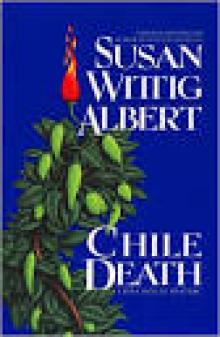 Chile Death
Chile Death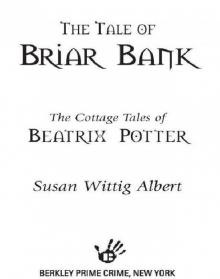 The Tale of Briar Bank
The Tale of Briar Bank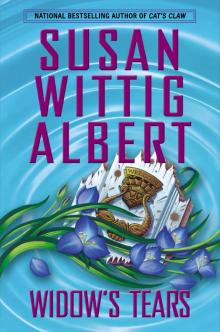 Widow's Tears
Widow's Tears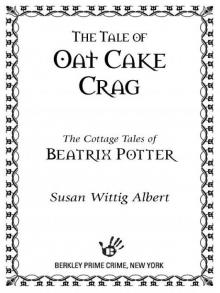 The Tale of Oat Cake Crag
The Tale of Oat Cake Crag Rueful Death
Rueful Death Bittersweet
Bittersweet The Darling Dahlias and the Poinsettia Puzzle
The Darling Dahlias and the Poinsettia Puzzle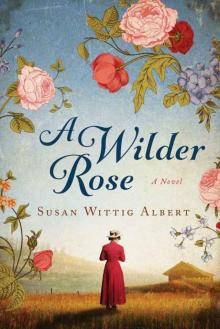 A Wilder Rose: A Novel
A Wilder Rose: A Novel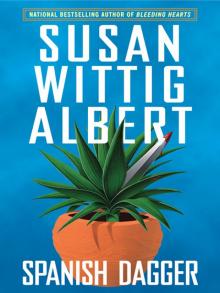 Spanish Dagger
Spanish Dagger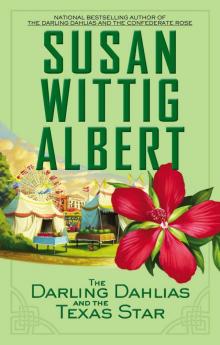 The Darling Dahlias and the Texas Star
The Darling Dahlias and the Texas Star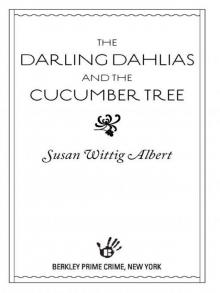 The Darling Dahlias and the Cucumber Tree
The Darling Dahlias and the Cucumber Tree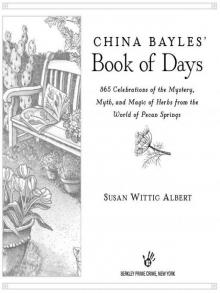 China Bayles' Book of Days
China Bayles' Book of Days Death Come Quickly
Death Come Quickly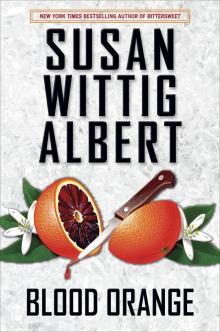 Blood Orange: A China Bayles Mystery
Blood Orange: A China Bayles Mystery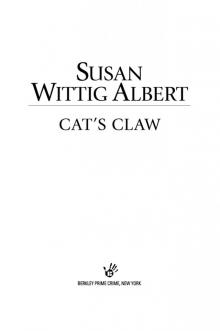 Cat's Claw
Cat's Claw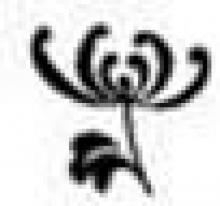 The Darling Dahlias and the Naked Ladies
The Darling Dahlias and the Naked Ladies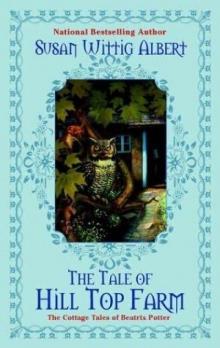 The Tale of Hill Top Farm
The Tale of Hill Top Farm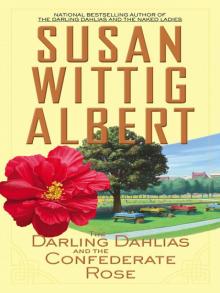 The Darling Dahlias and the Confederate Rose
The Darling Dahlias and the Confederate Rose The Darling Dahlias and the Silver Dollar Bush
The Darling Dahlias and the Silver Dollar Bush The General's Women
The General's Women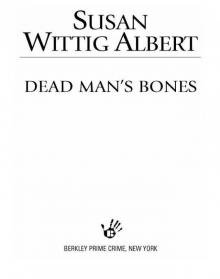 Dead Man's Bones
Dead Man's Bones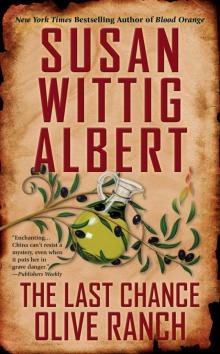 The Last Chance Olive Ranch
The Last Chance Olive Ranch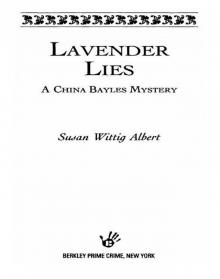 Lavender Lies
Lavender Lies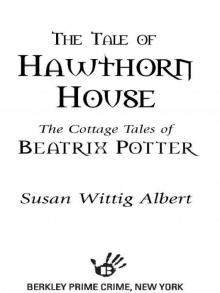 The Tale of Hawthorn House
The Tale of Hawthorn House The Tale of Castle Cottage
The Tale of Castle Cottage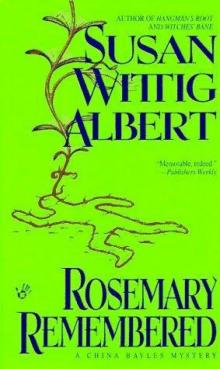 Rosemary Remembered - China Bayles 04
Rosemary Remembered - China Bayles 04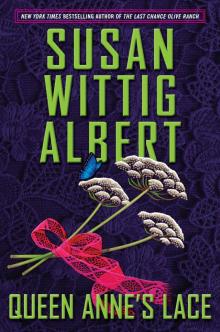 Queen Anne's Lace
Queen Anne's Lace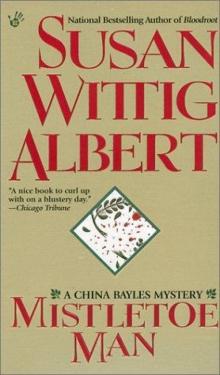 Mistletoe Man - China Bayles 09
Mistletoe Man - China Bayles 09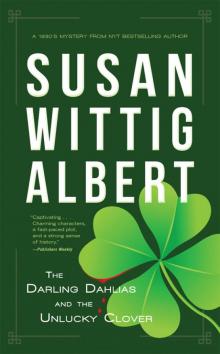 The Darling Dahlias and the Unlucky Clover
The Darling Dahlias and the Unlucky Clover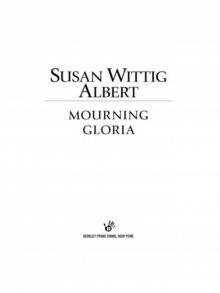 Mourning Gloria
Mourning Gloria The Darling Dahlias and the Eleven O'Clock Lady
The Darling Dahlias and the Eleven O'Clock Lady